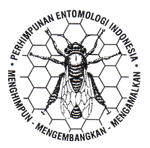Keanekaragaman dan kelimpahan Collembola pada perkebunan kelapa sawit di Kecamatan Bajubang, Jambi
DOI:
https://doi.org/10.5994/jei.14.2.51Keywords:
inactive pathway area, organic matter, rainfall, weedly zone areaAbstract
Collembola are essentials for soil health, because of their are as decomposers of organic material. However, Collembola are still not widely know in Indonesia. Information about Collembola is very limited, especially in oil palm plantations, so it is very interesting to study. The research aims to study the abundance and diversity of Collembola and also examines the influence of environmental factors (rainfall and humidity) toward Collembola population. The study was conducted in smallholder oilpalm plantations in four villages namely Bungku, Pompa Air, Sungkai, and Singkawang at Bajubang Jambi. The observations were conducted in November 2013 until April 2014. Soil sampling is done by using a rectangular blade measuring 16 cm x 16 cm which is inserted into the ground as deep as 5 cm. Soil samples were taken on four plots located in four villages. At each location a single plot of 50 m x 50 m is made. Soil sampling was performed on the weedly zone area and inactive pathway area for 6 months, 3 samples on the open ground and 3 samples on the compost line randomly. The results showed that Collembola obtained from all observed areas were 3 orders, 7 families, and 21 genus with a total abundance of 21,951 individuals. Collembola abundance found on the weedly zone area numbered 9,960 individuals consisted of 3 orders, 6 families, and 17 genus. While at inactive pathway area numbered 11,991 individuals consisted of 3 orders, 7 families, 16 genus. Among the three orders found Entomobryomorpha has the highest abundance of 19,999 individuals, both on the weedly zone area and inactive pathway area. From the results of research suspected that high and low levels of abundance and diversity influenced by fertilization, drought, and herbicides. Fertilization of the organic matter can increase abundance, were while drought and herbicide can reduce abundance of Collembola.
Downloads
Downloads
Additional Files
Published
How to Cite
Issue
Section
License
Authors who publish with this journal agree to the following terms:
- Authors retain copyright and grant the journal right of first publication with the work simultaneously licensed under a Creative Commons Attribution 4.0 International License that allows others to share the work with an acknowledgement of the work's authorship and initial publication in this journal.
- Authors are able to enter into separate, additional contractual arrangements for the non-exclusive distribution of the journal's published version of the work (e.g., post it to an institutional repository or publish it in a book), with an acknowledgement of its initial publication in this journal.
- Authors are permitted and encouraged to post their work online (e.g., in institutional repositories or on their website) prior to and during the submission process, as it can lead to productive exchanges, as well as earlier and greater citation of published work (See The Effect of Open Access).








